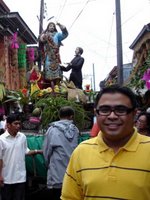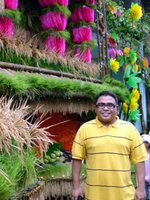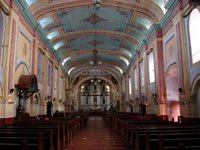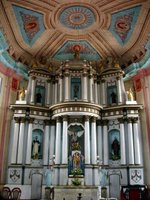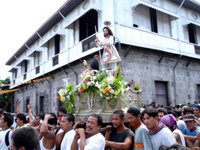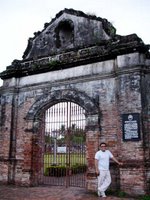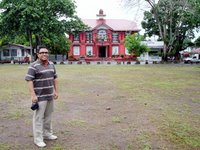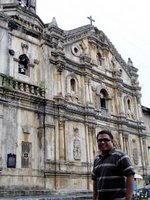Quezon celebrates the feast of San Isidro Labrador, patron saint of farmers, on May 15 every year, with colorful festivals. The Pahiyas Festival in Lucban is the most popular and no doubt, the most lively of the festivals! Here's a guide to help you experience the Pahiyas Festival.
The day starts with a Mass at 6 a.m. at the Lucban Church. It is followed by a procession of the images of San Isidro Labrador and his wife, Santa María de la Cabeza (Blessed Maria Torribia), that leaves the church at 7 a.m. It makes its way around Lucban's designated procession route for the year. There are years when a marching band accompanies the procession, announcing its arrival along the route. But there are times that there is none, which unfortunately makes the fiesta atmosphere less lively.
Not all houses in Lucban decorate for the Pahiyas Festival. Only houses along the procession route are decorated. And every year, the procession route changes. It takes about seven years before the procession passes by a house again, giving a household enough time to save resources and prepare for the colorful and ostentatious decorations that are an inherent part of the Pahiyas Festival.
In between the morning procession and the parade in the afternoon, visitors get to walk around town and look at the colorful decorations called pahiyas, thus the name of the festival. You can also go shopping at the many stalls and a tiangge featuring handicrafts from Quezon and Laguna. Some use the time to explore other towns, or visit restaurants and resorts outside Lucban.
At about 3 p.m., a lively parade makes its way around town. Unfortunately, this parade has been invaded by not so subtle commercial advertising. Some people like it. But I don't. So I usually end up in Tayabas to watch the procession and the riotous agawan of suman (glutinous rice cakes).
In the evening, there's a different atmosphere in Lucban. The same decorated homes now compete for the evening pahiyas competition. Lighting becomes an important factor. And the procession route becomes a fantastic display of color and lights.
Traveling to Lucban, Quezon
There are two routes to Lucban, the one via Los Baños and Pagsanjan, and the other via San Pablo City and Maharlika Highway. I recommend the one via Los Baños after experiencing heavy traffic along Maharlika Highway (total standstill for an hour at 4 a.m. due to a truck accident). And since there are so many buses and trucks, the route can get really dangerous.
If you're taking a private car, you have to leave Manila before 4 a.m. if you want to make it to the morning procession. That also means there are more parking slots available outside town when you arrive. It's best to park farther away (for ease when leaving) and then just take a tricycle to the drop-off point.
Those who don't want to drive can join a tour, which is more convenient than taking public transportation, especially since all roads lead to Lucban, Tayabas and Sariaya.
Things to eat in Lucban
Lucban longganisa tops the list of things to eat and take home from Lucban. You can enjoy them deep-fried served with rice and egg in restaurants and stalls, or grilled on a stick along the street.
Pancit habhab is another favorite. While it's available along the parade route and sold in small servings on banana leaves (Php10), I noticed the ones at restaurants tend to have more toppings.
Read more on the Pahiyas Festival, Agawan Festival in Sariaya and Mayohan sa Tayabas.
The day starts with a Mass at 6 a.m. at the Lucban Church. It is followed by a procession of the images of San Isidro Labrador and his wife, Santa María de la Cabeza (Blessed Maria Torribia), that leaves the church at 7 a.m. It makes its way around Lucban's designated procession route for the year. There are years when a marching band accompanies the procession, announcing its arrival along the route. But there are times that there is none, which unfortunately makes the fiesta atmosphere less lively.
Not all houses in Lucban decorate for the Pahiyas Festival. Only houses along the procession route are decorated. And every year, the procession route changes. It takes about seven years before the procession passes by a house again, giving a household enough time to save resources and prepare for the colorful and ostentatious decorations that are an inherent part of the Pahiyas Festival.
In between the morning procession and the parade in the afternoon, visitors get to walk around town and look at the colorful decorations called pahiyas, thus the name of the festival. You can also go shopping at the many stalls and a tiangge featuring handicrafts from Quezon and Laguna. Some use the time to explore other towns, or visit restaurants and resorts outside Lucban.
At about 3 p.m., a lively parade makes its way around town. Unfortunately, this parade has been invaded by not so subtle commercial advertising. Some people like it. But I don't. So I usually end up in Tayabas to watch the procession and the riotous agawan of suman (glutinous rice cakes).
In the evening, there's a different atmosphere in Lucban. The same decorated homes now compete for the evening pahiyas competition. Lighting becomes an important factor. And the procession route becomes a fantastic display of color and lights.
Traveling to Lucban, Quezon
There are two routes to Lucban, the one via Los Baños and Pagsanjan, and the other via San Pablo City and Maharlika Highway. I recommend the one via Los Baños after experiencing heavy traffic along Maharlika Highway (total standstill for an hour at 4 a.m. due to a truck accident). And since there are so many buses and trucks, the route can get really dangerous.
If you're taking a private car, you have to leave Manila before 4 a.m. if you want to make it to the morning procession. That also means there are more parking slots available outside town when you arrive. It's best to park farther away (for ease when leaving) and then just take a tricycle to the drop-off point.
Those who don't want to drive can join a tour, which is more convenient than taking public transportation, especially since all roads lead to Lucban, Tayabas and Sariaya.
Things to eat in Lucban
Lucban longganisa tops the list of things to eat and take home from Lucban. You can enjoy them deep-fried served with rice and egg in restaurants and stalls, or grilled on a stick along the street.
Pancit habhab is another favorite. While it's available along the parade route and sold in small servings on banana leaves (Php10), I noticed the ones at restaurants tend to have more toppings.
Read more on the Pahiyas Festival, Agawan Festival in Sariaya and Mayohan sa Tayabas.




















